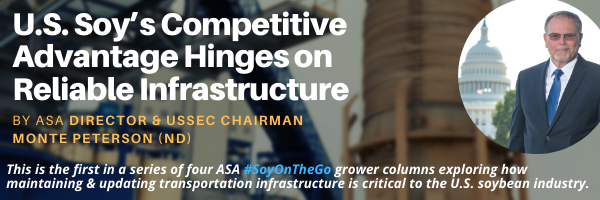Nov 12, 2021

By Monte Peterson • ASA Director & USSEC Chairman
It’s no secret the world is increasingly global, and we as U.S. citizens benefit from having access to a broader array of goods, products and technologies delivered right to our doorstep. U.S. soybean farmers also benefit from access to global markets, as approximately 60% of the soy grown each year is exported for use by food, feed and consumer packaged goods (CPG) companies. Soy is the U.S.’s No. 1 food and agriculture export.
The past 18 months—under the grip of COVID-19 and overstretched global supply chains—have shown both the resiliency and fragility of our systems. Despite a local drought and increasing insect and weed pressures, U.S. farmers and the supply chain are resilient, growing a record crop this year and hitting a new record for soy exports. While this is reason for applause, it didn’t happen without issue. We saw examples of infrastructure fragility, weak links, and various challenges, in particular container shipments that have caused shortages for many buyers around the world.
Among our international customers, U.S. soy has earned its reputation and market share on quality and reliability. Because of the climate and internal infrastructure in many other parts of the world, our customers rely on just-in-time-delivery of U.S. soy. It’s the efficiency of our infrastructure that helps preserve the quality of U.S. soy and makes for the best end-user experience for customers, and we want to keep this reputation intact.
Without the ability to reliably supply just-in-time orders, customers may experience increased spoilage, product degradation, a lower nutritional profile and a loss to their bottom line. U.S. soy stands out from soy of other origins because of this very service—and it hinges on our infrastructure and ability to move soy efficiently and effectively off farms and to customers around the world.
This year alone, soy exports will add $34 billion to the rural and farm economy. Let’s protect the future of our farm economy and use wisely our country’s recent investments in infrastructure, which will benefit not only U.S. farmers but also enable nutrition, food security and improve livelihoods worldwide.